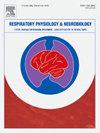伊马替尼通过体内和体外P38 MAPK和NF-κB信号通路对脂多糖诱导的急性肺损伤和内皮功能障碍的影响
IF 1.6
4区 医学
Q3 PHYSIOLOGY
引用次数: 0
摘要
背景:本研究的主要目的是证明伊马替尼(IMA)对小鼠急性肺损伤(ALI)模型和人脐血管内皮细胞中脂多糖(LPS)诱导的炎症的预防作用。方法:LPS刺激24h诱导ALI和细胞炎症。采用干湿比、肺血管通透性测量和髓过氧化物酶免疫组化评价肺病理结果。采用RT-PCR和酶联免疫吸附法分析促炎介质的表达。western blotting分析蛋白水平。免疫荧光法检测细胞连接结构。结果:IMA改善了lps诱导的肺病理损伤,降低了肺干湿比和肺组织中髓过氧化物酶的表达。IMA降低支气管肺泡灌洗液炎症细胞计数和血液中肿瘤坏死因子-α (TNF-α)、白细胞介素(IL)-6和单核细胞趋化蛋白1 (MCP-1)的释放。IMA预处理人脐血管内皮细胞可显著减弱lps诱导的肌动蛋白应激纤维形成和血管内皮-钙粘蛋白破坏。IMA还下调了血管细胞粘附分子1、细胞间粘附分子1、IL-1β、IL-6 mRNA丰度和肿瘤坏死因子-α(TNF-α)表达。IMA在体内和体外处理后,LPS诱导的p65、核因子- κB抑制剂α (IκBα)、p38、细胞外信号调节激酶和Jun n -末端激酶的磷酸化均减弱。结论:IMA可调节核因子κ B和丝裂原活化蛋白激酶信号通路及促炎细胞因子的产生,预防LPS感染引起的细胞损伤。这些结果表明,IMA可能是lps诱导的ALI的潜在调节剂。本文章由计算机程序翻译,如有差异,请以英文原文为准。
Effect of imatinib on lipopolysaccharide‑induced acute lung injury and endothelial dysfunction through the P38 MAPK and NF-κB signaling pathways in vivo and in vitro
Background
The primary purpose of this study was to demonstrate the preventive effects of imatinib (IMA) on lipopolysaccharide (LPS)-induced inflammation in a mouse model of acute lung injury (ALI) and human umbilical vascular endothelial cells.
Methods
LPS stimulation for 24 h induced ALI and cell inflammation. The pathological results of the lungs were evaluated using the wet/dry weight ratio, pulmonary vascular permeability measurements, and myeloperoxidase immunohistochemistry. The expression of pro-inflammatory mediators was analyzed using RT-PCR and enzyme-linked immunosorbent assay. Protein levels were analyzed using western blotting. The structure of cell junctions was detected using immunofluorescence.
Results
IMA improved LPS-induced pulmonary pathological damage and reduced the lung wet/dry weight ratio and myeloperoxidase expression in the lung tissue. IMA decreased bronchoalveolar lavage fluid inflammatory cell count and the release of tumor necrosis factor-α (TNF-α), interleukin (IL)-6, and monocyte chemotactic protein 1 (MCP-1) in the blood. Pretreatment of human umbilical vascular endothelial cells with IMA significantly attenuated LPS-induced actin stress fiber formation and vascular endothelial-cadherin disruption. In addition, IMA downregulated the mRNA abundances of vascular cell adhesion molecule 1, intercellular adhesion molecule 1, IL-1β, IL-6, and tumor necrosis factor-α(TNF-α) expression. The phosphorylation of p65, nuclear factor-kappa B inhibitor alpha (IκBα), p38, extracellular signal-regulated kinase, and Jun N-terminal kinase induced by LPS were attenuated after IMA treatment in vivo and in vitro.
Conclusions
IMA modulates the nuclear factor-kappa B and mitogen-activated protein kinase signaling pathways and the production of pro-inflammatory cytokines to prevent cellular damage due to LPS infection. These results indicate that IMA may be a potential modulator of LPS-induced ALI.
求助全文
通过发布文献求助,成功后即可免费获取论文全文。
去求助
来源期刊
CiteScore
4.80
自引率
8.70%
发文量
104
审稿时长
54 days
期刊介绍:
Respiratory Physiology & Neurobiology (RESPNB) publishes original articles and invited reviews concerning physiology and pathophysiology of respiration in its broadest sense.
Although a special focus is on topics in neurobiology, high quality papers in respiratory molecular and cellular biology are also welcome, as are high-quality papers in traditional areas, such as:
-Mechanics of breathing-
Gas exchange and acid-base balance-
Respiration at rest and exercise-
Respiration in unusual conditions, like high or low pressure or changes of temperature, low ambient oxygen-
Embryonic and adult respiration-
Comparative respiratory physiology.
Papers on clinical aspects, original methods, as well as theoretical papers are also considered as long as they foster the understanding of respiratory physiology and pathophysiology.

 求助内容:
求助内容: 应助结果提醒方式:
应助结果提醒方式:


